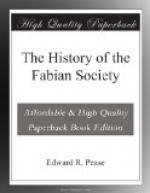Scarcely less active was Joseph F. Oakeshott, who has been already mentioned in connection with the Fellowship of the New Life. He joined the Executive when it was first enlarged in 1890, and sat until 1902. A Somerset House official, like Macrosty, he was strong on statistics, and for many years he undertook the constant revisions of the figures of national income, in the various editions of our “Facts for Socialists,”
His “Democratic Budget” (Tract 39) was our first attempt to apply Socialism to taxation: and his “Humanising of the Poor Law” (Tract 54), published in 1894, set out the policy which in recent years has been widely adopted by the better Boards of Guardians.
John W. Martin sat on the Executive from 1894 to 1899, wrote Tract No. 52, “State Education at Home and Abroad” (1894), and did a lot of valuable lecturing, both here and in America, where he married the leading exponent of Fabianism and editor of a monthly called “The American Fabian,” and, settling in New York, has since, under the name of John Martin, played a considerable part in the educational and progressive politics of his adopted city.
* * * * *
I will conclude this chapter with a short account of some of the applications of Socialism to particular problems which were studied by the Society in or about this period of its history.
In 1897 and 1898 a good deal of time was devoted to working out a scheme for the municipalisation of the Drink Trade. This was before the publication of “The Temperance Problem and Social Reform,” by Joseph Rowntree and Arthur Sherwell, in 1899, a volume which was the first to treat the subject scientifically on a large scale. I took the lead on the question, and finally two tracts were published in 1898, “Liquor Licensing at Home and Abroad” (No. 85), giving a sketch of the facts, and “Municipal Drink Traffic” (No. 86), which set out a scheme drafted by me, but substantially modified as the result of discussions by the Executive Committee and by meetings of members. This is one of the few causes taken up by the Society which has made but little progress in popular favour in the seventeen years that have elapsed since we adopted it.




